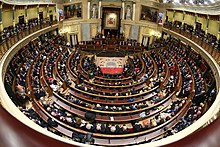
Back Congreso d'os Deputaus AN مجلس النواب الإسباني Arabic Congresu de los Diputaos AST Congrés dels Diputats Catalan Kongres poslanců Španělska Czech Congreso de los Diputados German Κογκρέσο των Αντιπροσώπων Greek Congreso de los Diputados Esperanto Congreso de los Diputados Spanish Diputatuen Kongresua Basque
Congress of Deputies | |
|---|---|
| 15th Congress of Deputies | |
 | |
| Type | |
| Type | |
| History | |
| Founded | 1834 |
| Leadership | |
| Structure | |
| Seats | 350 |
 | |
Political groups | Government (147)
Supported by (32) Opposition (171) |
| Elections | |
| Closed list proportional representation, D'Hondt method | |
Last election | 23 July 2023 |
| Meeting place | |
 | |
| Palacio de las Cortes Madrid, Community of Madrid Kingdom of Spain | |
| Website | |
| congreso | |
| Rules | |
| Standing Orders of the Congress of Deputies (English) | |
The Congress of Deputies (Spanish: Congreso de los Diputados) is the lower house of the Cortes Generales, Spain's legislative branch, the upper house being the Senate. The Congress meets in the Palace of the Parliament (Palacio de las Cortes) in Madrid.
Congress has 350 members elected from fifty-two constituencies (the fifty provinces and two autonomous cities) using closed list D'Hondt proportional representation. Deputies serve four-year terms. The presiding officer and speaker is the President of the Congress of Deputies, who is elected by the members at the first sitting of Congress after an election.
The two principal bodies in Congress are parliamentary groups and parliamentary committees (Spanish: comissiones). All MPs are required to be members of a parliamentary group,[1] the institutionalised form of political parties. Groups act with one voice represented by their spokesperson. In other words, the Spanish Parliament is a parliament of groups, not individual MPs who are constrained to act only as part of the group.[2][3] MPs can only act autonomously when submitting oral or written questions.[4]
As a result of the 2019 general election, there were 168 female deputies or 48% of all members, making Spain the European country with the highest percentage of women in parliament, surpassing Sweden and Finland.[5]
Cite error: There are <ref group=lower-alpha> tags or {{efn}} templates on this page, but the references will not show without a {{reflist|group=lower-alpha}} template or {{notelist}} template (see the help page).
- ^ Congress Standing Orders, Section 23.
- ^ Sánchez de Dios 1999, p. 150,159.
- ^ Jalali & Rodríguez Teruel 2019, p. 49,52.
- ^ Jalali & Rodríguez Teruel 2019, p. 52.
- ^ "Which European country has the most female politicians?". The Economist. 3 May 2019. ISSN 0013-0613. Retrieved 13 June 2019.